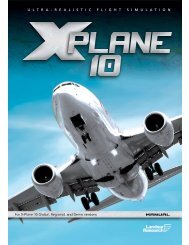Download the Plane Maker Manual - X-Plane
Download the Plane Maker Manual - X-Plane
Download the Plane Maker Manual - X-Plane
You also want an ePaper? Increase the reach of your titles
YUMPU automatically turns print PDFs into web optimized ePapers that Google loves.
8.4. ATTACHING 3-D OBJECTS 91<br />
not great. <strong>Plane</strong> <strong>Maker</strong> cannot make <strong>the</strong> complex model required for a 3-D cockpit, and it cannot<br />
create a highly detailed model of <strong>the</strong> craft as a whole to overlay <strong>the</strong> basic <strong>Plane</strong>-<strong>Maker</strong> model from<br />
which flight physics are calculated.<br />
Instead, you can use a 3-D modeling program (such as 3ds Max, Blender, Google SketchUp,<br />
or AC3D) to create <strong>the</strong>se objects. You can use any modeler able to export to <strong>the</strong> X-<strong>Plane</strong> OBJ<br />
file format. Many of <strong>the</strong> more popular modelers have plug-ins available to enable this; even if your<br />
modeler does not support it, you may be able to export to AC3D and save to an OBJ from <strong>the</strong>re.<br />
Note, however, that <strong>the</strong> X-<strong>Plane</strong> OBJ format is not <strong>the</strong> same as <strong>the</strong> Alias OBJ format.<br />
Regardless of which modeler you use, note that in order to use <strong>the</strong> OBJ with X-<strong>Plane</strong>, <strong>the</strong> file<br />
must use one texture per object.<br />
You can find plug-ins for exporting from AC3D on <strong>the</strong> X-<strong>Plane</strong> Wiki. For exporting from Blender<br />
or SketchUp, see Jonathan Harris’ plug-ins on his site. For danklaue’s updated Xplane2Blender<br />
script, see its X-<strong>Plane</strong>.org <strong>Download</strong> page.<br />
The easiest way to get started modeling an aircraft is to let <strong>Plane</strong> <strong>Maker</strong> create a starting<br />
point OBJ for you. To do this, first create <strong>the</strong> ACF version of <strong>the</strong> craft in <strong>Plane</strong> <strong>Maker</strong>. Then,<br />
open <strong>the</strong> Special menu and click ”Generate OBJ from Aircraft.” <strong>Plane</strong> <strong>Maker</strong> will create a file<br />
called ”aircraft.obj” in your top-level X-<strong>Plane</strong> directory. This OBJ can <strong>the</strong>n be imported into your<br />
modeling program for fur<strong>the</strong>r editing.<br />
Note that, in <strong>the</strong> export, <strong>Plane</strong> <strong>Maker</strong> will ignore any parts of <strong>the</strong> aircraft set to invisible. If<br />
you want all parts of <strong>the</strong> aircraft in your exported OBJ, open <strong>the</strong> Invisible Parts dialog box from<br />
<strong>the</strong> Special menu and click <strong>the</strong> “Show all parts” button.<br />
8.4 Attaching 3-D Objects<br />
Having created .obj files for X-<strong>Plane</strong> per <strong>the</strong> proceeding section, you can add objects to your aircraft<br />
file in one of two ways. The 3-D cockpit object will automatically be added to <strong>the</strong> aircraft when<br />
it is saved as [ACF file name] cockpit.obj in <strong>the</strong> top level of <strong>the</strong> aircraft’s directory. O<strong>the</strong>r objects<br />
must be manually added to <strong>the</strong> aircraft using <strong>the</strong> Miscellaneous Objects dialog box.<br />
While miscellaneous objects can use a texture file with any name <strong>the</strong>y specify (so long as <strong>the</strong> OBJ<br />
file references it), <strong>the</strong> 3-D cockpit must use a texture named [ACF file name] cockpit texture.png,<br />
and it must be stored in <strong>the</strong> aircraft’s top-level directory.<br />
Miscellaneous objects (all OBJ files which are not [ACF file name] cockpit.obj) must be stored<br />
in your aircraft directory, in a subdirectory called “objects.”<br />
Figure 8.4: Controls for adding a miscellaneous object<br />
With <strong>the</strong> miscellaneous objects saved in <strong>the</strong> correct location, open <strong>the</strong> Miscellaneous Objects<br />
dialog box from <strong>the</strong> Standard menu. Using <strong>the</strong> two tabs in this dialog, you can attach up to 24<br />
objects to <strong>the</strong> aircraft. To place an object in a given “slot” here, first click <strong>the</strong> small square in<br />
<strong>the</strong> left-center of <strong>the</strong> window. This will open a standard “Open File” dialog box, where you can<br />
navigate to your aircraft’s “objects” folder and select an OBJ file.<br />
With <strong>the</strong> object loaded, you can use <strong>the</strong> standard position controls (as described in <strong>the</strong> section<br />
“Fundamental Concepts” of Chapter 3) found here to change <strong>the</strong> object’s location and heading.<br />
Some aircraft designers, however, prefer to have <strong>the</strong> relative positioning of each piece of <strong>the</strong> aircraft<br />
set in <strong>the</strong>ir 3-D modeler, thus bypassing <strong>the</strong> positioning in <strong>Plane</strong> <strong>Maker</strong>.














